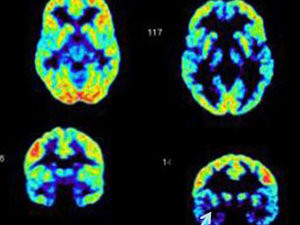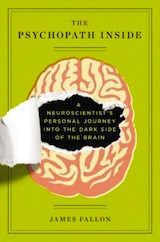Neuroscientist James Fallon has been studying the brains of psychopaths since the 1990s at the University of California, Irvine, trying to uncover anomalies in their neural activity. After looking at the brains of several violent and serial murderers using imaging technology, he found a pattern of reduced neural activity in centers of the brain responsible for empathy and ethics.
 James Fallon (far right) with his wife, daughters, and son.
© Courtesy of Jim Fallon, via NPR
James Fallon (far right) with his wife, daughters, and son.
© Courtesy of Jim Fallon, via NPR
Not long after sending off a paper with his results, he began working on another study on the brains of Alzheimer’s patients. While looking at fMRI’s of his control subjects, some of which included his own family members, he found that one control subject’s brain showed activity patterns similar those of the psychopaths he’d been studying. Too curious to let it go, he “unblinded” the study to find out who the brain belonged to and made a startling discovery: The brain was his.
This led Fallon down a path of questioning his assumptions about the role of nature versus nurture in shaping psychopathy and to look more closely at his own past behavior and character. The result was a book, published in 2013, The Psychopath Inside: A Neuroscientist’s Personal Journey into the Dark Side of the Brain, in which he both examines what is known about the “psychopathic brain” and speculates on the potential healing effects of a loving upbringing.
Describing himself as a “prosocial psychopath,” Fallon makes a case that biology is not destiny and that some traits associated with psychopathy might even make positive contributions to society. I interviewed him about the psychopathic brain, prospects for prevention and treatment, how nature and nurture work together to shape our personalities—and his own struggles with empathy and compassion.
Jill Suttie: You’ve studied the brains of criminally violent psychopaths and found certain anomalies. What are they?
James Fallon: All of them had a loss of activity in the limbic system—the emotional brain—and, for the most part, that was the most obvious difference, including a lowering of activity in the orbital cortex and adjacent ventromedial prefrontal cortex—that part that sits right over your eyes and nose. There was also abnormal and generally lower activity in the amygdala at the end of the temporal lobe, plus lower activity in a small strip of cingulate cortex that looks like a big “C” and that connects the orbital cortex and the amygdala.
JS: What’s the significance of this lower brain activity?
JF: In looking at it all, it makes some sense, as psychopaths have a problem with emotional regulation and its integration with the cold cognitive “thinking” part of the upper half of the frontal lobe. That area of the brain—the orbital cortex—controls impulsivity, but it also controls the sense of ethics and morality. It’s a part of the brain that keeps you from doing things considered morally wrong—that helps stop inappropriate behavior, that is outside of acceptable social context for a particular society.
The other part of the brain that was lower in activity was the amygdala. That’s like your “Id.” It controls rage, aggression, eating, drinking, sexuality, predatory behavior—all of the things that our inner animal finds necessary. But if that’s turned on, and it’s not being inhibited by the orbital cortex, you’ve got a really wild, raging person. Normally, in a balanced brain, they inhibit each other; but if they’re both down, that pattern is associated with a psychopath.
Now, if we’re talking about impulsive killers (not psychopaths), those people don’t have a problem in the amygdala; they have problems in the orbital cortex, so that they just can’t control a rage when it‘s started, and they feel a lot of remorse. That’s different than someone who’s a predator. A psychopath doesn’t feel the remorse.
JS: In your book you talk a lot about empathy and the differences between cognitive empathy—or perceptually recognizing what another person is thinking and feeling—versus emotional empathy—or feeling what another person is feeling. What does research say about the relationship between these two kinds of empathy and psychopathy?
JF: Emotional empathy is what most people think about and care about, because it has to do with bonding to another person—a mate, a mother, father, really close relationships. People who have great cognitive empathy, on the other hand, are the people we think of who do great works—who save the world: perhaps Gandhi, Mother Teresa, Nelson Mandela.
A psychopath can have a very high form of cognitive empathy, too. In fact, they are very good at reading other people. They seem like they can read minds sometimes. But even though they can understand people’s emotions, it doesn’t register emotionally with them—they have no emotional empathy. They understand people feel pain; but they use that information to use that other person. If they’re also a criminal, it makes them that much more dangerous, because they can read you and then use you better.
 Fallon's brain (on the right) has dark patches in the orbital cortex, the area just behind the eyes. This is the area that Fallon and other scientists say is involved with ethical behavior, moral decision-making and impulse control. The normal scan on the left is his son's.
© Scan and text via NPR
Fallon's brain (on the right) has dark patches in the orbital cortex, the area just behind the eyes. This is the area that Fallon and other scientists say is involved with ethical behavior, moral decision-making and impulse control. The normal scan on the left is his son's.
© Scan and text via NPR
JS: You mentioned Helen Mayberg’s work in your book. She has found that deep brain stimulation can help relieve intractable depression. Do you think some kind of deep brain stimulation could help psychopaths?
JF: Mayberg was stimulating the brain to turn something off—cingulate cortex area 25. By turning it off, she was able to stop depression immediately.
But turning things off and turning them on is not the same thing, particularly when you are talking about circuits. You’d be stimulating an entire area, and all the subsets of neurons and adjacent fiber areas involved, especially in the cortex, would fight each other. But it’s theoretically possible to go into one spot in the amygdala, because it’s about the same size as the Helen Mayberg spot, and to stimulate that while simultaneously inhibiting the other spot next door. That could be tried.
The thing is, just having cognitive empathy and not emotional empathy is not considered clinically abnormal. If you want to start doing that to people—people with high cognitive empathy but low emotional empathy—then you get rid of people like Gandhi. It’s not abnormal, whereas chronic depression is always abnormal. It’s only in the context of other connections that are off—the lack of emotional empathy and a dysregulation of the emotional response, stress response, etc.—that a psychopath is created. So you’d have to go in and tinker with about five places at once for psychopaths.
JS: Aren’t psychopaths notorious for not wanting treatment?
JF: Yeah, usually they’re just pissed that they got caught. I don’t know of any really consistent finding of treating psychopathy…unless you start treating them, perhaps, when they’re three or four years old. After that, the brain connections are so fundamentally flawed—they’re actually missing functional parts—that nothing seems to really work. You can do temporary things; but I think the disconnection is too fundamentally flawed.
JS: But that brings me to you and your case. You found out accidentally you had this same brain pattern, and that you also carry something you call the warrior gene, which is implicated in psychopathy; yet you aren’t a psychopath. You call yourself a “prosocial psychopath,” in fact. What do you mean by that?
JF: There are about 20 different traits associated with psychopaths that can be broken down into three basic factors. The first has to do with how you interact with other people; the third has to do with sexual behavior—deviant or hypersexual, or unreliable marital relationships. Then there’s the 2nd factor, much of which is what is associated with ASPD—anti-social personality disorder. Many parts of factor 1 are prosocial, because they allow you to navigate in society.
And, actually, people have confidence in you; they trust you. Factor 2, which is associated with ASPD, is associated with criminality. I have no elements of Factor 2, but have elements of the rest of them. So, I’m like a grand bull-shitter, and I’m on always on the make—not sexually, necessarily—but I’m always wanting to build a world that people want to come into, even if it’s for 5 minutes.
Before I saw those traits as just being charm. But when you turn it about 30 degrees, you realize, no, this isn’t charm; this is manipulating people. I also had 15 or so warrior genes—almost all of the ones associated with aggression—and I am very aggressive and perniciously competitive, to the point where no one would play games with me. In terms of empathy, I have all of those associated with cognitive empathy. You can see this reflected in the PET scans and EEG’s—very high activity in the part of my brain having to do with planning, executive functioning, special relationships, perception, and language. In the areas for emotional empathy, activity is quite low and poor.
JS: So how do you explain that you have this similar brain and gene pattern, but that you’re not anti-social?
JF: In a way, I’m trying to backfill the information in and create a story that makes sense. I started to realize the effect my family—my mother, father, grandparents, everybody—had on me. They really took care of me, more than others in the family. I was treated well. I was raised as kind of a golden child. After a couple of years of mulling this over, I eventually realized that I was really quite wrong about the role of nature and nurture on genes and how the environment and genes interact. The timing of that is very important, especially during the first years of life.
It had nothing to do with my character at all. I really don’t denigrate myself—I like myself, probably too much—but if I really honestly look at it, it was just luck. I was born, I was really cute, and, when I was in high school, I was an athlete, I had a good body, I was smart, I was the best dancer, all of this stuff. And having that, it carried through. I was able to use all of those things and apply them easily—I didn’t work that hard, really—and so life has been easy for me. So I don’t know what would have happened if I didn’t have that.
JS: Do you think that there are positive traits associated with psychopathy?
JF: I remember growing up in junior high school, high school, and beyond, some of my close friends told me, “It’s a good thing that you had that kind of girlfriend, it’s a good thing you had that growing up, because otherwise you’d have become a gang leader.” And I just laughed at that. But I’ve always been asked, from an early age, to take on leadership roles, whether I wanted them or not. That’s a trait—it’s called fearless dominance; but it’s also a psychopathic trait.
A study that came out this year used fearless dominance as the main psychopathic outcome variable. But look at all of our presidents. It turns out that ones that have the highest psychopathic traits—if we look at fearless dominance—were Teddy Roosevelt, JFK, FDR, Bill Clinton. The ones with the very low psychopathy were like Jimmy Carter—the mensches. If you look at the psychopathic trait, it lines up very well with what people consider leadership.
And, so, when is it a bad thing? It’s the kind of thing where there’s no clean answer. Because if we were able to wipe out all psychopathic traits by genetic engineering, we’d all be Gerald Ford, I guess, or Jimmy Carter. But unless you wipe out everybody, there are always opportunistic parasites who will take advantage of the situation in the world.
JS: So you assume that your loving upbringing helped you avoid developing full-blown psychopathy. Is there evidence for this?
JF: I never gave this much thought. It never seemed that important to me—I was so much into the biology and genetics of things.
But recent research on one of the serotinin system warrior genes, the SERT (serotonin transporter promoter) gene, has shown that while those with the high risk allele who undergo early abuse/abandonment will be at risk for later violence and aggression, those with the same allele who undergo a very positive (loving) early environment will be at lower risk for such behaviors.
It is as if, in the first two or three years of life, the vulnerable prefrontal orbital and ventromedial cortex “sees” whether the environment one is born into is hostile or nurturing, and then “tunes” the cortex through the serotonin system to prepare for a lifetime in that environment.
This is good news because it means that you have the power to change in a positive direction. Benign or positive situations can offset negative genetic influences and environmental influences significantly.
JS: If this is true, does it mean we could prevent psychopathy?
JF: We know the effect of violence on kids who are susceptible—if they’ve got the biological parameters—the genetics and brain pattern—early abuse could induce psychopathy. So, the answer is to be very diligent about how we treat our kids, to really directly deal with the abandonment by primary parents.
We could also identify the 20 percent or so kids who are susceptible and watch them so we know that they are not bullied, they’re not abused, that they’re really watched early on. We could take a saliva sample and look at 30 candidate genes that are associated with these different types of empathy, violence, and anxiety, because it’s a profile.
If a kid has a suspicious profile, and he ends up engaging in early problematic behaviors, then that’s the time we can step in—not only to prevent abuse and bullying, but to try certain techniques that might work in kids that are three, four, or five. After five, it’s very difficult to treat burgeoning psychopathy. But some things could be done early.
JS: Are there early warning signs for psychopathy in kids?
JF: There aren’t great predictors. Every kid will experiment, and people can get too reactive to normal things that many kids will do. But of course any chronic thing is indicative of a problem. Two classic signs—early sexual activity and animal torture or killing—are useful to know; if they happen chronically, it’s usually not a good sign. But another suspected behavior—bedwetting—turns out not to be a good indicator at all.
Besides that, the way that a kid looks at you or look through you can be an indicator. But, the last time I wrote about this in 2005, I called that chapter, “My Granddaughter’s a Sociopath,” because basically every kid is going to look through you. In a way, every kid compared to an adult is a psychopath, because they don’t care about you; they’re just looking to get what they want. So then, how do you compare that to a kid that’s really too much that way?
JS: You’re doing some research looking at violence in neighborhoods and countries around the world. Can you describe it for me?
JF: My colleagues and I are putting together large grants to study the impact of living in different neighborhoods and of being in the military on the interaction between genes and brain imaging and all sorts of outcomes. We’ve been putting together proposals to study hot spots around the world—including Palestine, North Africa, Europe and a couple of places in the United States—to see the effect of trauma, abuse, micro-traumas, and bullying over the long haul on individuals and transgenerationally in part of society in these hot spots. We want to answer the question: Does the effect of an early positive environment really overcome genetics?
We look at the positive and negative outcomes—for example, we’re now studying the brains and genetics of people who’ve committed suicide, and we know of generals and colonels for whom combat war actually helped them, a kind of post-traumatic growth instead of depression—and we look at their brains to see how they’re different. There are people undergoing tremendous stressors in hot spots like the West Bank and North Africa, who, for some reason, come out smelling like a rose. And so, the idea that how much of this is genetic and how much is early environment, some of it is taking people who are older and who’ve been through it.
Also, if you have a population in one area or neighborhood with constant violence, and you go a mile away where it hasn’t been that way and you can see that they have the same kind of age, ethnic, educational pattern, etc. without the violence, then you can see how the behaviors are affected or how the genetics are different. You can look for epigenetic markers or tags [associated with changes in gene expression] that have to do with traits that jump generations.
The more new research that comes out, the more it seems that this “epigenetic jumping” may happen in areas of the brain like the orbital cortex that are connected to social behavior. Those are exactly the ones that have to do with psychopathy—with violence and anti-social behavior. So, the social brain is modifiable and, for someone who has been in a war zone or bad neighborhood, these traits can start concentrating, and you can build up a kind of warrior culture.
JS: Where do you hope this research will lead?
JF: The only way that you urge action is by showing something scientifically. We know warrior cultures don’t last. They end up beating each other/beating themselves up. So, if you can show that the result of making a culture of violence in an area of a city, or in a country or government, is that they’re going to kill themselves—because they are encouraging a psychopathic brain pattern to develop and allowing a warrior culture to take root and reproduce—then people will take notice.
Of course, we’re not going to make up the data. It’s got to come out that way. If it doesn’t, then, well, “Flame on!” What else are you going to say? But, the idea of showing why we must reduce the violence of war and stop poor parenting…well, that’s my real motivation for attacking it in this way.



Comments